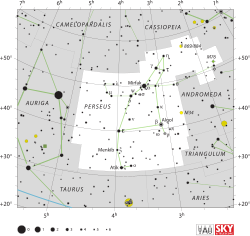Psi Persei
| Observation data Epoch J2000 Equinox J2000 |
|
|---|---|
| Constellation | Perseus |
| Right ascension | 03h 36m 29.37982s |
| Declination | +48° 11′ 33.4789″ |
| Apparent magnitude (V) | 4.310 |
| Characteristics | |
| Spectral type | B5Ve |
| U−B color index | −0.56 |
| B−V color index | −0.06 |
| Variable type | γ Cas |
| Astrometry | |
| Radial velocity (Rv) | −1.1 km/s |
| Proper motion (μ) |
RA: +22.55 mas/yr Dec.: −27.78 mas/yr |
| Parallax (π) | 5.59 ± 0.22mas |
| Distance | 580 ± 20 ly (179 ± 7 pc) |
| Details | |
| Radius | 4.7 ± 0.3 R☉ |
| Surface gravity (log g) | 4.0 cgs |
| Temperature | 16,053 ± 447 K |
| Rotational velocity (v sin i) | 390 km/s |
| Other designations | |
| Database references | |
| SIMBAD | data |
Psi Persei (Psi Per, ψ Persei, ψ Per) is a Be star in the northern constellation of Perseus. It has an apparent visual magnitude of 4.31, so it is visible to the naked eye at night under suitably dark skies. Based on parallax measurements, it is located at a distance of roughly 580 light-years (180 parsecs) from the Earth.
This star has a stellar classification of B5Ve, which indicates it is a B-type main sequence star that is generating energy at its core through the nuclear fusion of hydrogen. It is a shell star with a circumstellar disc of gas surrounding the equator and extending out to about 11 times the radius of the star. As a result of this disc, the spectrum of this star shows emission lines (as indicated by the 'e' in the stellar class) and its magnitude varies over a period of about a day.
Psi Persei is rotating rapidly with a projected rotational velocity (v sin i) along the equator of 390 km/s or more. The axis of rotation is inclined about 75° ± 8° to the line of sight from the Earth, so this velocity is close to the actual azimuthal velocity along the star's equator. It is expelling mass at the rate of about 5.0 × 10−8 times the mass of the Sun per year, or the equivalent of the Sun's mass every 20 million years. This star may be a member of the Alpha Persei Cluster, although its proper motion is high compared to other members.
...
Wikipedia

